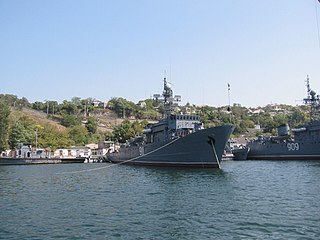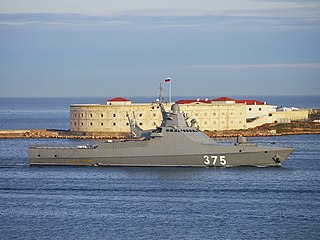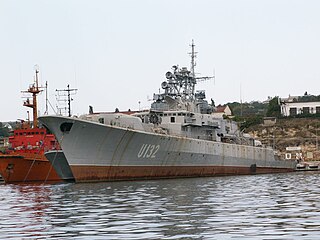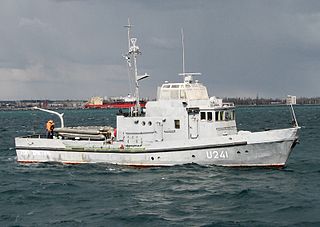
The Russian navy is the naval arm of the Russian Armed Forces. It has existed in various forms since 1696; its present iteration was formed in January 1992 when it succeeded the Navy of the Commonwealth of Independent States.

The Ukrainian Navy is the maritime forces of Ukraine and one of the five branches of the Armed Forces of Ukraine.

The Baltic Fleet is the fleet of the Russian Navy in the Baltic Sea.

The Neustrashimy class, Soviet designation Project 11540 Yastreb (hawk), is a series of large frigates built for the Soviet Navy and currently in service with the Russian Navy. Seven ships were planned for the Soviet Navy, but the fall of the Soviet Union disrupted those plans. Two ships were completed, both currently in active service with the Russian Baltic Fleet.

The Petya class was the NATO reporting name for a class of light frigates designed in the 1950s and built for the Soviet Navy in the 1960s. The Soviet designation was "Storozhevoi Korabl`" Project 159.

The Zubr class, Soviet designation Project 1232.2, is a class of Soviet-designed air-cushioned landing craft (LCAC). The name "Zubr" is Russian for the European bison. This class of military hovercraft is, as of 2023 the world's largest hovercraft, with a standard full load displacement of 555 tons. The hovercraft was designed to sealift amphibious assault units from equipped/non-equipped vessels to non-equipped shores, as well as to transport and plant naval mines.

The Ropucha class, Soviet designation Project 775, is a class of landing ship built in Poland for the Soviet Navy. The ships were built in the Stocznia Północna shipyards in Gdańsk, Poland. They were designed for beach landings, and can carry 450 tons of cargo. The ships have both bow and stern doors for loading and unloading vehicles, and the 630 square metres (6,800 sq ft) of vehicle deck stretch the length of the hull. Up to 25 armored personnel carriers can be embarked.

Tapir-class landing ship, Soviet designation Project 1171 landing ship is a class of Soviet/Russian general purpose, beachable amphibious warfare ships.

The Buyan class, Russian designations Project 21630 Buyan and Project 21631 Buyan-M, are series of corvettes developed by Zelenodolsk Design Bureau for the Russian Navy. Since 2010, all subsequent vessels are being constructed as improved Project 21631 subclass, incorporating greater tonnage, stealth technology and the 3S14 vertical launching system for either Kalibr or Oniks anti-ship cruise missiles, significantly enhancing combat capabilities. The ships are primarily designed for operations within littoral zones to protect Russia's vast coastal areas. Due to the small tonnage, they can operate even within shallow parts of oceans and seas and Russia's extensive inland waterway system. The export variant is known as Project 21632 Tornado.

The Natya class, Soviet designation Project 266M Akvamarin, were a group of minesweepers built for the Soviet Navy and export customers during the 1970s and 1980s. The ships were used for ocean minesweeping.

Vinnytsia (U206) was an anti-submarine corvette of the Ukrainian Navy. Prior to joining the Ukrainian Navy she was a former KGB Border Guard patrol ship named Dnepr. In March 2014, she was seized by Russian soldiers and de facto came under control of the Russian Black Sea Fleet. The ship was returned to the Ukrainian Navy from Crimea on 19 April 2014.

Ochakov was a Kara-class cruiser of the Russian Navy Black Sea Fleet. She was decommissioned in 2011 but remained laid-up in Sevastopol, until on 3 March 2014 she was towed and sunk as a blockship in the channel to Donuzlav lake, in Novoozerne, in western Crimea. A few months later she was refloated and returned to Inkerman to await scrapping. Ochakov was scrapped at Inkerman in 2015.

Southern Naval Base was a naval base of the Armed Forces of Ukraine located in the town of Novoozerne on Donuzlav Bay in the western part of Crimea.

Donbas was a Project 304 former Soviet repair ship that was converted to a command ship of the Ukrainian Navy. She was built on Szczecin Shipyard in Poland in 1969 for the Soviet Navy and entitled PM-9. "PM" is a Russian abbreviation for a repair ship, and literally means a floating repair shop. Donbas was destroyed during the Siege of Mariupol as a part of the 2022 Russian invasion of Ukraine.

The Karakurt class, Russian designation Project 22800 Karakurt, is a class of Russian corvettes which have been entering service with the Russian Navy since 2018.

Project 22160 is a series of large patrol ships being constructed for the Russian Navy. The vessels are primarily intended for duties such as patrol, monitoring and protection in open and closed seas. The first ship was laid down in February 2014 and joined the Russian Navy in December 2018. By January 2018, six ships were under construction. Between 2017 and 2022, four ships had been launched.

The Ukrainian frigate Sevastopol was a former Soviet frigate Razitelnyy of the Burevestnik-class ship built for the Soviet Navy in the late 1970s.

Shtil' was a Nanuchka-class corvette in the Soviet Navy and later the Russian Navy.

The Samum is a Bora-class corvette in the Soviet Navy and later the Russian Navy. In Soviet and later Russian classification, it is considered a "small missile ship". Like the rest of the class, it's a surface effect ship armed with anti-ship missiles.

Hola Prystan (P241) is a Project R1415 anti-sabotage boat of the Ukrainian Navy. Built in 1986, she has been in Ukrainian Navy service since 1997.




















